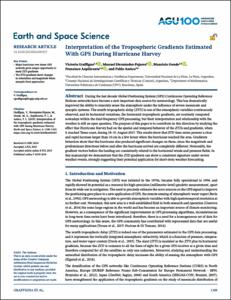Mostra el registre d'ítem simple
Interpretation of the tropospheric gradients estimated with GPS during hurricane Harvey
| dc.contributor.author | Graffigna, Victoria |
| dc.contributor.author | Hernández Pajares, Manuel |
| dc.contributor.author | Gende, Mauricio |
| dc.contributor.author | Azpilicueta, Francisco |
| dc.contributor.author | Antico, Pablo |
| dc.contributor.other | Universitat Politècnica de Catalunya. Departament de Matemàtiques |
| dc.date.accessioned | 2020-01-30T13:00:51Z |
| dc.date.available | 2020-01-30T13:00:51Z |
| dc.date.issued | 2019-01-01 |
| dc.identifier.citation | Graffigna, V. [et al.]. Interpretation of the tropospheric gradients estimated with GPS during hurricane Harvey. "Earth and Space Science", 1 Gener 2019, vol. 6, núm. 8, p. 1348-1365. |
| dc.identifier.issn | 2333-5084 |
| dc.identifier.uri | http://hdl.handle.net/2117/176202 |
| dc.description.abstract | During the last decade Global Positioning System (GPS) Continuous Operating Reference Stations networks have become a new important data source for meteorology. This has dramatically improved the ability to remotely sense the atmosphere under the influence of severe mesoscale and synoptic systems. The zenith tropospheric delay (ZTD) is one of the atmospheric variables continuously observed, and its horizontal variations, the horizontal tropospheric gradients, are routinely computed nowadays within the dual-frequency GPS processing, but their interpretation and relationship with the weather is still an open question. The purpose of this paper is to contribute in this direction by studying the effect that Hurricane Harvey had on the spatial and temporal behavior of the ZTDs and gradients, when it reached Texas coast, during 18–31 August 2017. The results show that ZTD time series present a clear and rapid increase larger than 10 cm in a few hours when the hurricane reached the area. Gradients behaviors show that the hurricane also produced significant changes on them, since the magnitude and predominant directions before and after the hurricane arrived are completely different. Noticeably, the gradient vectors before the landing are consistently related to the horizontal winds and pressure fields. In this manuscript we demonstrate that the ZTD gradients can show a consistent signature under severe weather events, strongly suggesting their potential application for short-term weather forecasting. |
| dc.format.extent | 18 p. |
| dc.language.iso | eng |
| dc.subject | Àrees temàtiques de la UPC::Matemàtiques i estadística::Matemàtica aplicada a les ciències |
| dc.subject.lcsh | Geophysics |
| dc.title | Interpretation of the tropospheric gradients estimated with GPS during hurricane Harvey |
| dc.type | Article |
| dc.subject.lemac | Geofísica |
| dc.contributor.group | Universitat Politècnica de Catalunya. IonSAT - Grup de determinació Ionosfèrica i navegació per SAtèl·lit i sistemes Terrestres |
| dc.identifier.doi | 10.1029/2018EA000527 |
| dc.description.peerreviewed | Peer Reviewed |
| dc.subject.ams | Classificació AMS::86 Geophysics |
| dc.relation.publisherversion | https://agupubs.onlinelibrary.wiley.com/doi/full/10.1029/2018EA000527 |
| dc.rights.access | Open Access |
| local.identifier.drac | 25816150 |
| dc.description.version | Postprint (published version) |
| local.citation.author | Graffigna, V.; Hernandez, M.; Gende, M.; Azpilicueta, F.; Antico, P. |
| local.citation.publicationName | Earth and Space Science |
| local.citation.volume | 6 |
| local.citation.number | 8 |
| local.citation.startingPage | 1348 |
| local.citation.endingPage | 1365 |
Fitxers d'aquest items
Aquest ítem apareix a les col·leccions següents
-
Articles de revista [3.259]
-
Articles de revista [87]


